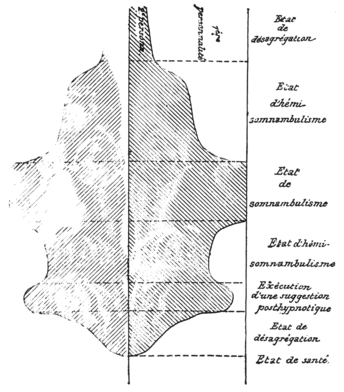Pierre Marie Félix Janet1859–1947
Janet classified neuroses and developed a method of treating them called psychological analysis. Concepts like the subconscious and l’idée fixe (obsessional ideas) were coined by him: “The idée fixe of the hysteric is subconscious. This term should not lead to any philosophical quarrels. It is not a question of deciding that the mind is, or is not, divisible. The term subconscious expresses simply the fact that the patient sometimes can, and other times cannot express his obsessive idea”. He distinguished between the neurotic states of hysteria and psychasthenia, a distinction that was to influence Jung’s categories of extroverted and introverted personalities. Janet’s psychological analysis was similar to that developed independently by Delboeuf, and later by Freud. It initially consisted of returning the patient (in the following case of Marie) by suggestion to the traumatic effects that precipitated the neurosis: “I was able to efface the idea only by a singular means. It was necessary to bring her back by suggestion to the age of thirteen years, to put her back into the initial conditions of the delirium, and then to convince her that her [menstrual] period had lasted three days and had not been interrupted by any unfortunate accident”. Janet was born in Paris, was educated at its University, and spent most of his life in that city. His early psychological interests were focused by his hypnotic treatment of a celebrated clairvoyant and hysteric called Léonie, and other patients. For this work, published as Psychological Automatism (1889), he received his doctor of letters. This came to Charcot’s notice and he appointed Janet director of the newly formed experimental psychology laboratory at La Salpêtrière; Janet then completed his studies for a doctorate in medicine. For Janet hypnosis was a psychological rather than a physiological phenomenon. Indeed, his study of the early history of the magnetizers led him to realise the likely causes of Charcot’s erroneous interpretations of hysterical behaviour. In 1902, in competition with Binet, Janet was elected to the most prestigious post in French psychology - professor of experimental and comparative psychology at the Collège de France. He gave annual lectures on different subjects and published extensively until his retirement in 1935, but his elevation did remove him from the sources of his inspiration - his patients. He was a cofounder and editor of the Journal de Psychologie Normale et Pathologique in 1904. Janet’s ideas were very similar to those advanced by Freud, and they evolved in the first decades of this century. However, as Freud’s influenced waxed Janet’s waned, partly because he did not attract such dedicated disciples and partly because his work was not translated into English. His wan portrait is split into two states, corresponding to the dissociation of the personality during hypnosis, as it was illustrated in his first book.
